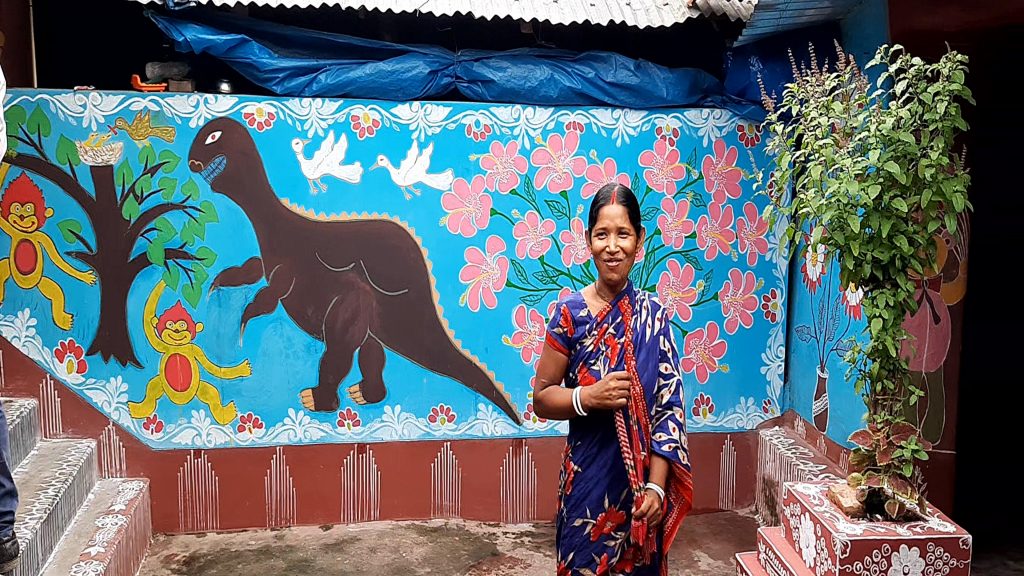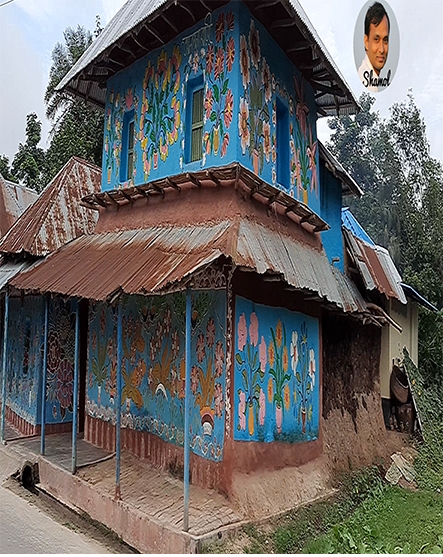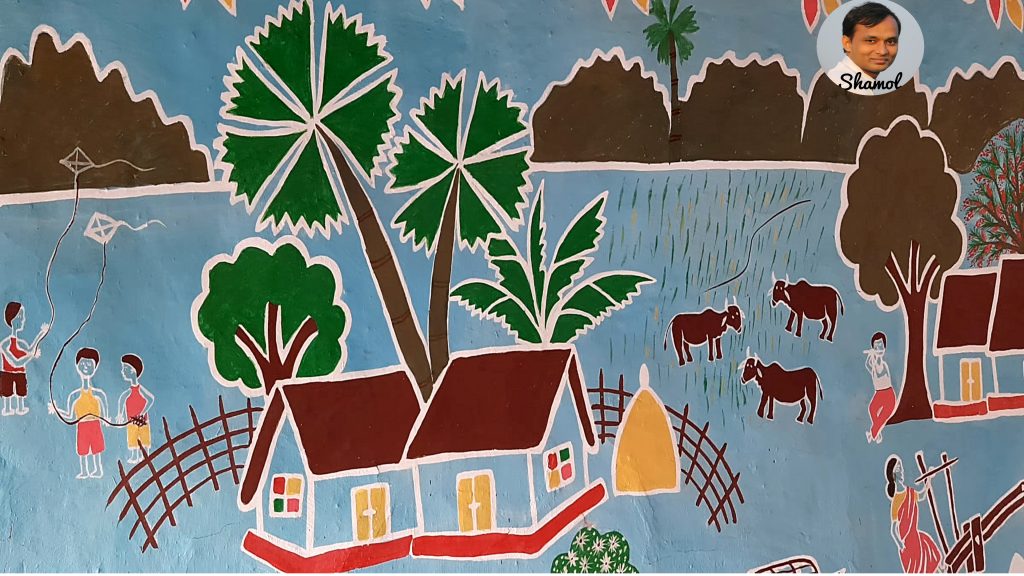Alpona Gram of Nachol upazila of Chapainawabganj. Today I will show you the various types of beauty of Alpona village and I will try to highlight the various paintings of the beauty of public life. Talk to people. I hope you will join me.
Greetings and best wishes to all. Today I will take you, the leader of Tebhaga movement In the land of Ila Mitra.

That means Tikoil of Chapainawabganj. I will show you the name of the village Alpona village and how this Alpona has spread and turned into beauty of our culture. Talk to you soon and keep up the good content. I will listen to those who have decorated this village with a natural beauty.
There are about ninety traditional religious families here. About 400 people live in this village. He described this village as a uniquely beautiful village in Bangladesh. That is why many people from home and abroad come here every day, every day. I got there today. I am Shamol Nath with you today. So let’s go.
One of the artisans of the Alpona house saw Mrs. Anita Barman, daughter of Barman. I asked her about various issues of Alapona village. Then he said,

1. So we heard the name of Alpona village and saw Alpana house written in front of your house. What’s the secret?
Answer: Mother has been doing Alpina for a long time. When there was no color, there was no brush. At that time mother used to paint with red soil and banana juice. Now this is the color. So along with mom, we also paint. My girls paint too. So it was known as Alpona Bari. Other houses have also been painted as we watched. This house is known as Alpana village. That’s why many people come and see. We did it to make ourselves feel good. Now it is a matter of pride for us that everyone likes it. .
2. How old are you drawing this Alpana?
Ittar: I hear my mother got married when she was 12-13 years old. Mother is married, mother did not study or could not. From then on, my mother started drawing. Then when I grew up, I saw my mother say, if I design more, it will be better. At that time he used to do alpana with plain and red soil. In doing so, the mother’s experience increased. Then mother started painting.
3. Do you enjoy doing this?
A: In fact, it is our hobby. I will decorate the house. We like it better. Alpana is an old tradition. We will hold on to this tradition. This is what we want to make more flourish.
It’s better to keep saying,
Alpona has now become a part of Bengali culture in West Bengal and Bangladesh. Alpana is more commonly used in weddings and cultural events. However, for several years, Alpana was painted on a large scale even on wide highways. For example, in our country, on the occasion of New Year, Alpona is painted on the streets of Dhaka on the first day of Boishakh or on the day of Language Martyrdom on 21st February.
The number of people in these families is more than four hundred. All the women of the village are painters. To the women of the village, the walls and floors of every house are like a canvas. With the touch of their hands, every house, from the kitchen to the bedroom, the walls and the floor of every house are full of craftsmanship.
First from an Alpona house in the village now to Alpana village. These Hindu communities have been living in this village for more than one and a half hundred years. The daughters-in-law of this village have perpetuated this tradition on the walls of their houses for years. None of the walls inside and outside these mud houses are spared from the aesthetic scratch of the brush.
According to the Alpona artists of this village, Alpona used to be painted in only a few houses. Gradually the women of all the houses of the village decorated the house by painting Alpona. Twice a year – Lakshmi Puja and Durga Puja the house is decorated. In both the pujas all the houses of the village are decorated with alpana. Earlier the name of this village was Tikil but recently everyone knows the village as ‘Alpona village’. Now people of the country and abroad know Alpana as a village.https://en.wikipedia.org/wiki/Painting
But if all the walls of a house in a village, there would be a little bit of exterior, what would it look like? Great! Some beauty can never be understood or felt without seeing it with one’s own eyes. The ‘Alpona Village’ of Chapainawabganj continues to carry such a beauty.
-
Tikil is a village in Nejampur union of Nachol Upazila of Chapainawabganj.
which is reminiscent of Ila Mitra, the undisputed leader of the Tebhaga movement. This village is now known to everyone as ‘Alpona Village’.
The main artisans of this village are housewives and girls. Domestic artists have perpetuated this tradition on the walls of the house for years in the lineage.
The women of this village paint alpona on the walls of the house to enhance the beauty of the house and seek the blessings of the gods. Basically, in the village of Tikil, more alpana is done on the walls of the house on the occasion of Puja-Parvan. And this alpana has been adorning the walls of houses all over the village for years.
Many people also make different colors to make the alpana painted on the walls of these houses last longer. They make their own color by mixing dried big, crushed mango shell, chalk powder, manakchu and banana peels with different colors. And the alpona painted in that color survives all year round on the earthen walls.
According to the Alpona artists of this village, Alpona used to be painted in only a few houses. Gradually the women of all the houses of the village decorated the house by painting Alpona. Twice a year.
The aesthetic touch of this artistic painting starts from the hands of women.
Although it is now a matter of great regret, the truth is that the use of this alpona in the Poush festival of the followers of traditional religions is ubiquitous, but now it has become less and less.
This village is now known as (The Alpona Village / A Village of Alpona).
At one time chalk, chalk, clay, paint and turpentine oil were used to draw this alpona. But the durability of that alpona was very low. So at present the mixture is made by soaking the soil, dried plum powder, chalk powder, different colors, manakchu and banana tree husk for 4 to 5 days. And this Arpana lasted for more than a year. The locals believe that this alpona bring sanctity to the house and keep all the members of the family happy.
However, many have no idea how such a tradition was born in the village of Tikil.
Yet they continue to preserve the ancestral heritage in various festivals, festivities and joyous occasions. it’s Looks like a music. I think I am listening to Lata Mangesker’s song.
Anyone Can see more about as Audio Visual Click on youtube :

Shamol Nath is a writter & Documentary film Director. Shamol Nath Write and made documetaries over the decade.
He mainly focus on literature and films. Write poems, story, eassy and recently write a novel etc.



